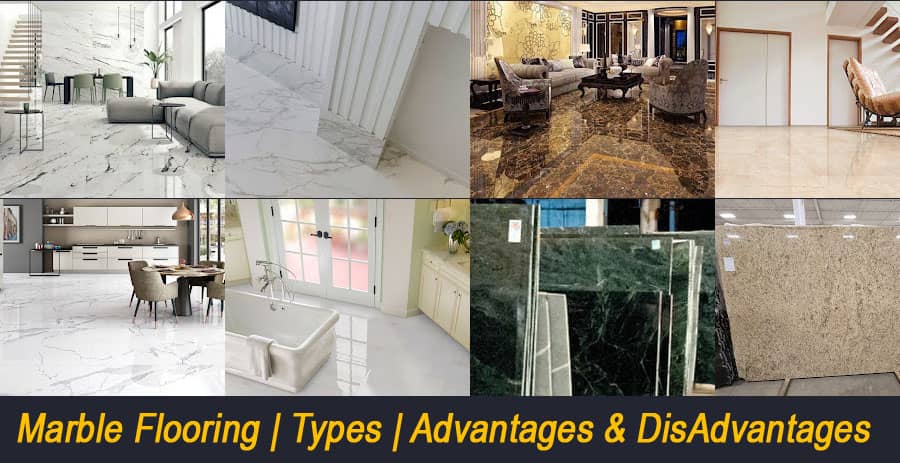Marble Flooring | Types | Advantages | DisAdvantages

Marble Flooring
Marble flooring is a type of flooring made from natural marble, a metamorphic rock that is formed when limestone is subjected to heat and pressure. Marble is a popular choice for flooring because it is durable, beautiful, and versatile. It can be used in a variety of settings, from kitchens and bathrooms to living rooms and bedrooms.
Types of Marble Flooring
- Carrara marble is a white marble with gray veins. It is the most popular type of marble flooring and is known for its elegant and timeless look.
- Calacatta marble is another type of white marble with gold or brown veins. It is more expensive than Carrara marble but is also more rare.
- Emperador marble is a brown marble with gold or black veins. It is a popular choice for modern and contemporary homes.
- Crema Marfil marble is a beige marble with light brown veins. It is a versatile option that can be used in a variety of settings.
- Statuario marble is a white marble with blue or pink veins. It is a luxurious and elegant choice for flooring.
- Bianco Dolomite marble is a white marble with gray or blue veins. It is a popular choice for both residential and commercial applications.
- Verde Antique marble is a green marble with black or brown veins. It is a unique and eye-catching option for flooring.
- Giallo Ornamentale marble is a yellow marble with black or brown veins. It is a bold and stylish choice for flooring.
- Travertine marble is a type of limestone that has a porous surface. It is a popular choice for patios and outdoor areas.
When choosing marble flooring, it is important to consider the following factors:
- Color and veining: The color and veining of the marble will affect the overall look of the space. Consider the decor of your home and choose a marble that will complement the other colors and materials.
- Durability: Marble is a durable material, but it can be scratched or stained if not properly cared for. Choose a marble that is appropriate for the traffic level in the area where it will be installed.
- Maintenance: Marble requires regular sealing to protect it from stains and damage. Be prepared to commit to the maintenance requirements of marble flooring before you choose it.
Marble flooring is a beautiful and luxurious option that can add value to your home. With so many different types of marble to choose from, you can find the perfect one to complement your style and needs.
Advantages and Disadvantages
Marble flooring is a popular choice for many homes because of its beauty, durability, and versatility. However, it also has some disadvantages that you should be aware of before making a decision.
Advantages of marble flooring:
- Durability: Marble is a very durable material that can withstand years of wear and tear. It is also resistant to scratches and stains, making it a good choice for high-traffic areas.
- Beauty: Marble is a naturally beautiful material that comes in a wide variety of colors and patterns. It can add a touch of luxury and elegance to any room.
- Versatile: Marble can be used in a variety of settings, from kitchens and bathrooms to living rooms and bedrooms. It can also be used to create accent walls or countertops.
- Heat conductivity: Marble is a good conductor of heat, which means it can help to keep your home cool in the summer and warm in the winter.
- Easy to clean: Marble is relatively easy to clean with a mild soap and water solution.
Disadvantages of marble flooring:
- Price: Marble is a relatively expensive flooring option.
- Porosity: Marble is a porous material, which means it can be stained by liquids and other substances. It is important to seal marble flooring regularly to protect it from stains.
- Slip hazard: Marble can be slippery when wet, so it is important to take precautions to prevent accidents.
- Sensitive to acids: Marble can be damaged by acids, so it is important to avoid using harsh cleaning products on it.
- Maintenance: Marble requires regular maintenance to keep it looking its best. This includes sealing, cleaning, and polishing.
Overall, marble flooring is a beautiful and durable option that can add value to your home. However, it is important to be aware of the disadvantages before making a decision.
Here are some tips for caring for marble flooring:
- Seal the marble regularly with a sealant that is designed for marble.
- Clean the marble with a mild soap and water solution.
- Avoid using harsh cleaning products on the marble.
- Be careful not to spill acidic substances, such as lemon juice or vinegar, on the marble.
- Polish the marble regularly to keep it looking its best.
By following these tips, you can help to extend the life of your marble flooring and keep it looking its best for years to come.
